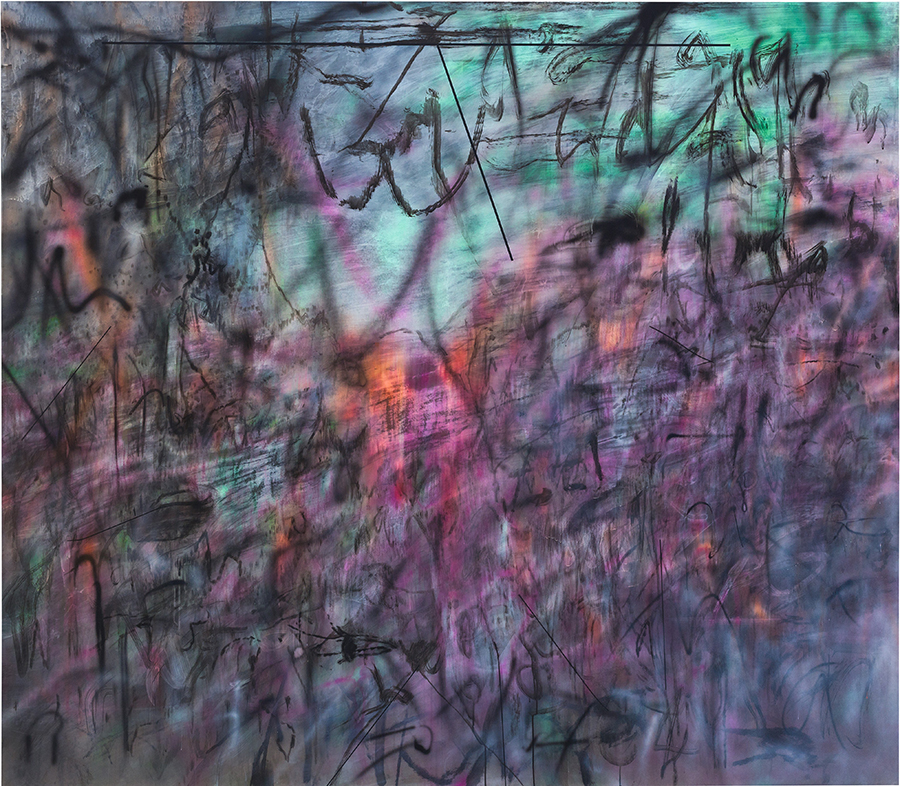Julie Mehretu Review: War, Racial Conflict and Migration Simmer Beneath Abstract Surfaces
The artist’s survey at LACMA showcases her dynamic engagement with the history of modernism and socio-political conflict
The artist’s survey at LACMA showcases her dynamic engagement with the history of modernism and socio-political conflict

Several paintings and etchings by Julie Mehretu from between 2013–14 bear the title Algorithm, suggesting a calculus extraneous to the artist’s hand. As captured in a short film (GDGDA, 2011) by fellow artist Tacita Dean, however, it is indeed Mehretu’s hand which applies the strokes and architectural silhouettes to her sprawling images. The Ethiopian-born, US-educated Mehretu has distinguished herself as one of the most talented artists of her generation, with a stylistic versatility matched by few. Spread over two floors, this mid-career survey includes a generous swathe of her outsized paintings along with drawings, watercolours and some lyrical departures from her characteristically architectural imagery. The arresting Being Higher I (2013), for instance, reveals a vaguely human form, arms outstretched in a seemingly messianic gesture of martyrdom or redemption – redolent, in a more allegorical vein, of the themes which have increasingly drawn Mehretu’s attention: war, exodus, racial conflict and migration.

Considering the centrality of drawing to Mehretu’s working method, the inclusion of numerous works on paper offer an instructive supplement to the large-scale canvases anchoring the exhibition. These works’ relegation to a small side gallery is somewhat unfortunate, however; the selection conveys a representative sense of the artist’s range on paper, from graphite and ink wash to aquatint and etchings with chine-collé, yet could have benefitted from more breathing room. The challenge is clearly one of scale: Mehretu’s large canvases would dwarf her quasi-hieroglyphic drawings, such as an untitled sketch from 1996, knitting diminutive, alphabet-like markings reminiscent of Paul Klee’s cryptic scripts into chains of form across an empty page. These spare marks seem wrought by an artist other than the painter of brash lines which swagger on hazy canvases in the central gallery nearby.

Indeed, the facility with which Mehretu moves between scales and styles is mesmerizing. More impressive still is the way these effects so often share the same pictorial space, in a complex layering of lines, textures and effects. Early paintings like Apropos (1998) delineate shallow, coloured quadrants over which the artist draws networks of spindly lines, evocative of topographical plans. This generates a disjuncture between the geometric flatness of the canvas and the ostensible remoteness of these tracings. Two decades later, the tension of such disjunctures appears at once heightened and expanded into an ever more frenzied matrix, by turns diaphanous and dense. Over time, Mehretu’s imagery has not only become more intricate, but has come to incorporate allusions to historical events. Black City (2007), for example, assimilates to its dense and angular surface representations of Nazi war bunkers.

The five panels of the striking polyptych Epigraph, Damascus (2016) reveal a calligraphic layering in aquatint and photogravure, which nevertheless evinces the spontaneity of painted strokes. The drawn architectural elements which sit beneath more blurred abstractions are rendered upside down, lending the work a vertiginous sense of disorientation, appropriate to its war-scarred subject. If the lattice of urban imagery lends some sense of placement, black smudges and smears suggest an ashy haze. The gargantuan canvas Cairo (2013) invokes the Arab Spring uprisings, but only through a web of wispy ink and acrylic, which congeals and dissipates amidst glimpses of Tahrir Square and inverted Cairene façades. Many of Mehretu’s works from the mid-2010s strike just this tension between precision and obscurity, place and mood, the topographic and the atmospheric.
The wall text for Mehretu’s Babel Unleashed (2001) describes it as reimagining the ‘ordered space found in traditional European painting’ – an absurd evasion of modernism, upon which the artist draws extensively, most notably by way of Wassily Kandinsky and Roberto Matta. Abstract expressionism also informs her palimpsestic imagery, redolent of a writing system which refuses legibility. In Indigene/Origine (overture) (2018–19), marks appear blurred as if glimpsed through a gauzy scrim or projected in shadow.

Mehretu’s practice is an exceedingly sophisticated affair, assimilating world history to non-objective mark-making – incorporating imagery from the 2014 protests in Ferguson, Missouri in Conjured Parts (eye), Ferguson (2016) for instance, or, more recently, the American detention centres callously enclosing migrants in Haka (and Riot) (2019). Yet this presentation of her work leans too heavily at times upon extensive wall texts, and numerous photographs of civil rights struggles in the catalogue, as if they might magically illuminate her abstractions. At its most exhilarating, Mehretu’s imagery is a spectacle unto itself.
























